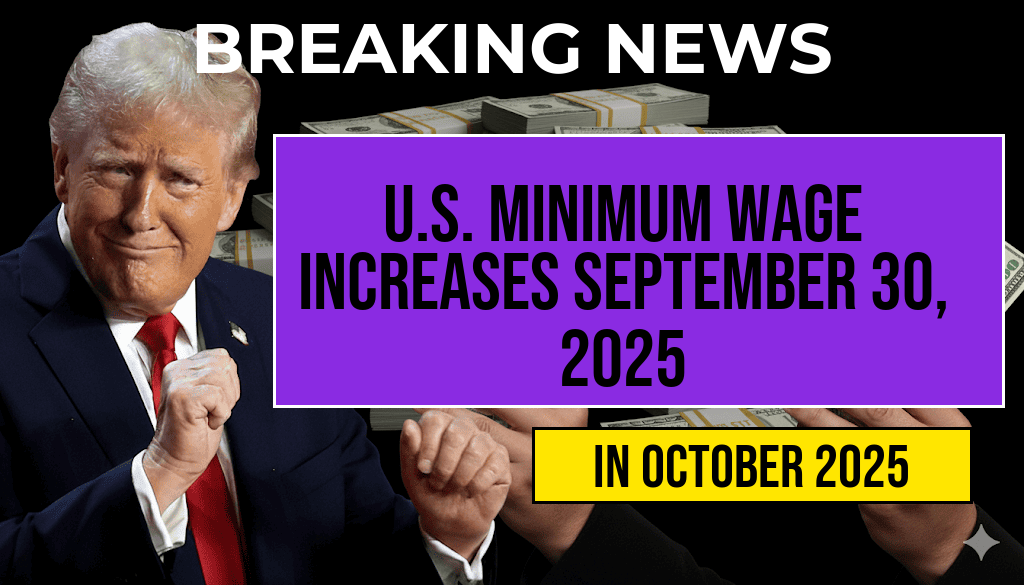The U.S. minimum wage is set to increase on September 30, 2025, marking a significant change in the national pay structure. This adjustment comes as part of ongoing legislative efforts aimed at improving the financial well-being of workers across the country. As such, many states and localities are gearing up to implement these changes, which will affect millions of employees and their employers. The new minimum wage will rise to $15 per hour, a figure that has been widely debated among lawmakers, business owners, and advocacy groups. This article provides a complete list of hourly wages anticipated in various states following the implementation of this federal mandate.
Background on Minimum Wage Legislation
The push for a higher minimum wage has gained momentum over the past decade, fueled by rising living costs and demands for workers to receive a fair wage for their labor. Organizations such as the Economic Policy Institute and various labor unions advocate for the increase, arguing that it would alleviate poverty and stimulate economic growth. Conversely, some businesses express concerns about potential impacts on employment rates and operational costs.
New Federal Minimum Wage Details
The increase to $15 per hour represents the first major adjustment to the federal minimum wage since it was last raised in 2009. As of 2025, all employers are required to comply with this new wage standard. Here’s what you need to know:
- Effective Date: September 30, 2025
- New Minimum Wage: $15.00 per hour
- Current Federal Minimum Wage: $7.25 per hour
State-Specific Minimum Wage Adjustments
While the federal minimum wage sets a baseline, many states have already enacted higher minimum wages. The upcoming federal increase will affect states differently, depending on their current wage laws. Below is a table showcasing the anticipated minimum wage for various states post-implementation:
| State | Current Minimum Wage | Projected Minimum Wage (2025) |
|---|---|---|
| California | $15.00 | $15.50 |
| New York | $15.00 | $15.00 |
| Texas | $7.25 | $15.00 |
| Florida | $11.00 | $15.00 |
| Washington | $15.74 | $16.00 |
| Illinois | $13.00 | $15.00 |
Impact on Workers and Employers
The adjustment to a $15 minimum wage is anticipated to have far-reaching implications for both workers and employers. For employees, particularly in low-wage sectors like retail and hospitality, this increase could mean enhanced purchasing power and improved living conditions. For employers, however, the change may necessitate adjustments in payroll budgets and could influence hiring practices.
Small businesses, in particular, are voicing concerns regarding their ability to sustain operations under the new wage requirements. The Small Business Administration encourages business owners to prepare for these changes by reviewing their financial plans and exploring available resources to manage the transition effectively.
Future Outlook and Ongoing Discussions
As the 2025 implementation date approaches, discussions surrounding minimum wage laws are expected to intensify. Advocacy groups will likely continue to push for higher wages, while opponents will present their case regarding the potential for job loss and economic strain on businesses. Observers will be keenly monitoring how states respond to the federal mandate, especially in regions where local laws exceed the federal minimum.
In the meantime, workers and employers alike should stay informed about their rights and responsibilities under the new minimum wage law, as compliance will be crucial. For more detailed information on the implications of the upcoming wage increase, refer to resources from the U.S. Department of Labor.
Frequently Asked Questions
What is the new minimum wage rate effective September 30, 2025?
The new minimum wage rate will increase to $15 per hour, reflecting ongoing efforts to ensure a livable wage for workers across the country.
Which states will see an increase in their hourly wages?
All states will be impacted by the federal minimum wage increase, but some states may have their own laws that set a higher hourly wage than the federal standard.
Are there any exceptions to the new minimum wage law?
Yes, certain categories of workers, such as tipped employees and those with disabilities, may have different pay structures that could affect their minimum wage rates.
How will this wage increase affect small businesses?
The wage increase may pose challenges for small businesses, but it is also expected to boost consumer spending as employees have more disposable income.
Where can I find the complete list of hourly wages by state?
A complete list of hourly wages by state will be available on the U.S. Department of Labor’s website and will be updated to reflect the changes effective September 30, 2025.

Leave a Reply